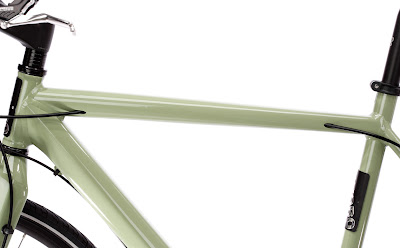 Swobo, the bike apparel company that made their name with cool, functional clothing and lovely merino jerseys, are now launching the Baxter. A light, yet low-maintenance, weather-proof urban performance bike with the usual, cool Swobo twist. Nice work!If I should quickly sketch up the perfect urban bicycle for those who need to get up, down and around efficiently and in style, without having to spend time tuning their machine, I guess the wish list would look pretty much exactly as the Swobo Baxter does:
Swobo, the bike apparel company that made their name with cool, functional clothing and lovely merino jerseys, are now launching the Baxter. A light, yet low-maintenance, weather-proof urban performance bike with the usual, cool Swobo twist. Nice work!If I should quickly sketch up the perfect urban bicycle for those who need to get up, down and around efficiently and in style, without having to spend time tuning their machine, I guess the wish list would look pretty much exactly as the Swobo Baxter does:Weather-proof Shimano disc brakes and eight internal gears. A nice, wide handlebar securing a comfortable riding position. Light, fast-rolling tires. A steel chain case, so you don't have to worry about oily pant legs. All put onto a light, aluminium frame with a carbon fork.
Swobo released their first line of bicycles back in 2007, designed and developed by designer and product manager Sky Yeager - in the industry well known for the rather fabulous models she once designed for Bianchi USA, the American division of the legendary Italian brand.
Now she is heading Swobo further into the market of cool, functional urban bicycles - with the new Baxter, as well as the more racy Crosby model.
Yes, it's superficial - judging from the pictures alone, but I'm already a fan of the Baxter: Bikes with this attitude are usually made of pretty heavy steel tubes, forsaking light weight and efficiency for old-fashioned streed cred. With the Baxter, Swobo and Sky Yeager has come up with an very well thought-out frameset flush with sweet details for the aficionado, yet clean and simple looking for the uninitiated.
Have a look.
 SLIDING DROPOUTS: If you are a bike geek, you'll appreciate this picture a lot.
SLIDING DROPOUTS: If you are a bike geek, you'll appreciate this picture a lot.  WIDE IS GOOD: This is the handlebar your hands would ask for if they could talk.
WIDE IS GOOD: This is the handlebar your hands would ask for if they could talk. INTERNAL AFFAIRS: Swobo could of course have fastened the brake cable for the rear wheel to the top tube with ordinary frame stops and zip ties. But Sky Yeager don't want that stuff snagging your pants, and put it inside the frame. Clean, tidy and smooth.
INTERNAL AFFAIRS: Swobo could of course have fastened the brake cable for the rear wheel to the top tube with ordinary frame stops and zip ties. But Sky Yeager don't want that stuff snagging your pants, and put it inside the frame. Clean, tidy and smooth.
 LIGHT BEER: The seat post have an integrated light which look great but won't allow you to lower the saddle. The saddle itself feature an integrated beer opener which can hardly be seen, but will allow you to lower your shoulders.
LIGHT BEER: The seat post have an integrated light which look great but won't allow you to lower the saddle. The saddle itself feature an integrated beer opener which can hardly be seen, but will allow you to lower your shoulders.
 GEEKERY: If you are a bike geek, you'll think: "Look! A trigger shifter for a internal gear hub! Wow!". If not, all you need to know that pressing the big lever will get you a lighter gear.
GEEKERY: If you are a bike geek, you'll think: "Look! A trigger shifter for a internal gear hub! Wow!". If not, all you need to know that pressing the big lever will get you a lighter gear.
VIEW FULL ARTICLE > > >

































